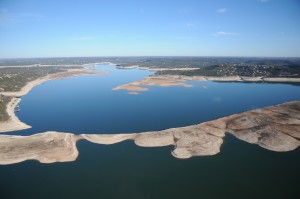Highland Lakes Residents Warned to Stop Suckin’ on Straws

Photo by LCRA
The extreme drought has lowered levels in Lake Travis, exposing formations not seen for some time.
Let’s say you live next to one of the Highland Lakes in Central Texas. And let’s say you have an expansive lawn that needs lots of water. Couldn’t you just run a line from your sprinkler to the lake and pump water out to keep your lawn green? Sure, you could do that. But you’d be breaking state law.
Drawing water from the lakes is a practice that’s been common for some time, but residents may not be able to get away with it for much longer. In a move they hinted at a few weeks back, the Lower Colorado River Authority (LCRA) announced Monday that they are going to “begin reporting residents who pump water from the Highland Lakes without a contract to the Texas Commission on Environmental Quality, which can levy fines for the illegal pumping.”
The LCRA estimates that “5,000 residents use pumps to pull water from the lakes for lawn watering and other uses in or around their homes,” using around 5,000 acre-feet of water a year. That’s over 1.3 billion gallons of water. The community of Spicewood Beach, by comparison, which recently ran dry, used almost 39 million gallons of water last year. The city of Austin used nearly 145,000 acre-feet of water last year, or about 47 billion gallons.
Of those 5,000 people pumping water out of the lake, the LCRA says that 2,000 of them have contracts, but more than 3,000 continue the practice without a contract. It was even worse a few years ago. In 2009, only 60 of those estimated 5,000 people had the proper contracts.
So how are they going to start reporting residents who are sucking water with their own straws?
Simple. If you have a contract to legally draw water, the LCRA will give you a big sticker to put on your intake pipe. Ostensibly those without the stickers will be easy to spot and report.
The price to legally buy water isn’t much. For an acre-foot, which is over 325,000 gallons, the LCRA charges the same rate they do for municipal and industrial customers (including water haulers), $151. Many homes use far less water than that on average.
The Highland Lakes have shown few signs of recovering from the record single-year Texas drought. They are currently at a combined 38 percent of their capacity and have shown little progress this winter, as much of the heavy rains in Central Texas passed them by. In 2011 alone, the lakes had three of their five record-lowest inflows. They haven’t seen this little water coming in since 1964, and the LCRA currently projects that they will reach new historic lows by the summer.
This graph from the LCRA shows levels of the main Highland Lakes (Buchanan and Travis) since the drought began. You can see that in December and January, they have had little recovery:
And those lakes aren’t alone in failing to show much progress out of the drought. State Climatologist John Nielsen-Gammon writes on this blog that while the drought has improved overall since September, “only in the north-central and eastern parts of the state have large reservoirs seen water storage increase by more than 5% of capacity.” The rest of the state hasn’t really seen their reservoir levels rise, “and a few major reservoirs in the western half of the state remain dry.”





